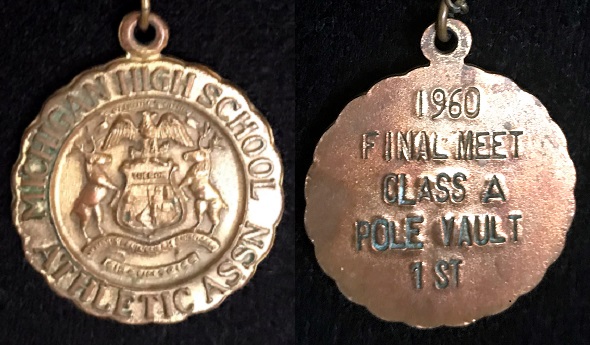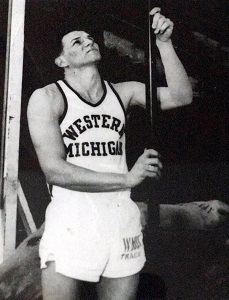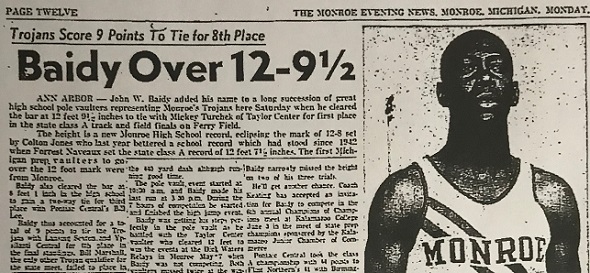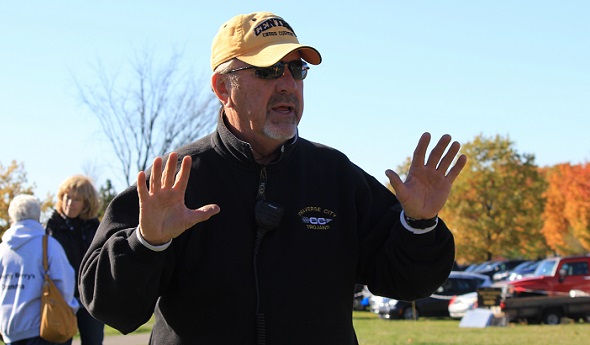
60 Years Later, Co-Champ Rediscovered
March 25, 2020
By Ron Pesch
Special for Second Half
Nicholas “Mickey” Turcheck tells a wild story. It involves a coin flip.
Involved in track & field for much of his life, Turcheck was a pole vaulter at Taylor Center during his high school days, then at Western Michigan University. He later served Taylor Center for more than three decades as track coach, where he mentored five state champions.
He also coached two future Olympians. Earl Jones, who won MHSAA Finals track titles in both 1980 and 1981, and grabbed bronze in the 800 meters at the 1984 Summer Olympics in Los Angeles. Another of his athletes, Deby LaPlante, qualified for the 1976 Summer Olympics in Montreal as a high hurdler.
In Turcheck’s possession is a medal. Etched on the back, pounded out in the style of the time, are five lines.
1960
FINAL MEET
CLASS A
POLE VAULT
1ST
Those 31 characters honor his MHSAA championship performance on what became a windy day in Ann Arbor at University of Michigan’s old Ferry Field.
But there is one problem. Turcheck’s name doesn’t appear on the MHSAA list of Finals champions. According to the list, the championship belongs to Joe Baldy of Monroe.
(The list has since been corrected and amended, per the story to be told below.)
Trackheads
For ‘trackheads’ – diehard fans of the sport and the events that comprise a track meet – as well as sports historians, a newspaper’s agate page is nirvana. Contained within the tiny type are the details that aren’t always relayed within the article covering a sporting event. Things like baseball batting averages, league standings, box scores, stat lines, team transactions, TV and radio schedules, and most everything else that doesn’t fix conveniently into the day’s sports section might appear on the page. For a track meet, a full agate listing will include place finishes as well as times, heights and distances that were used to determine winners of events, as well as detail on record performances that were equaled or topped.
Jim Moyes is a passionate sports fan. An undersized high school athlete at a small school, where participants of all shapes and sizes are valued, Moyes was the son of a prep coach at North Muskegon High School. He grew up and became, among other things, a beloved and respected broadcaster and public address announcer. Few were as well-prepared as Moyes, who studied agate pages, past performances, and, it seemed, the family trees of the participants prior to sitting before a microphone. His knowledge, as well as his sense of humor, was on display for 43 years in West Michigan, where he would balance his understanding and importance of an event with the awareness that, in the end, what we were experiencing was still just a game.
 Well over 30 years ago he began his research into a passion project. Moyes is a ‘trackhead.’ And, because of this, in 2019, he officially became the author of a published book.
Well over 30 years ago he began his research into a passion project. Moyes is a ‘trackhead.’ And, because of this, in 2019, he officially became the author of a published book.
Way back, Moyes began digging into microfilm with the goal of capturing the names and events behind each MHSAA Finals track championship. He shared his initial research with the MHSAA, and for years the Association has highlighted his work on its website with lists of individual state champions on both their boys and girls track pages.
A couple of years before wrapping up his research, Moyes began work with another certified ‘trackhead,’ Jeff Hollobaugh – associated editor of Track & Field News, the voice of countless track meets, and as Moyes states, an “expert on this great sport” – to tell the stories of the meets in book form. “The Fleet Feet of Spring” – a history of Michigan’s High School State Championships covering the span 1895-2018 – was the result.
That’s 24,446 state champions. Simply put, its 439 pages contain a marvelous collection of statistics, stories and images.
But, with good reason, Turcheck’s name doesn’t appear in the publication.
Golden Age of Newspapers
Post-event press coverage on the 1960 MHSAA State Track Meet for most readers across Michigan arrived in their newspaper courtesy of coverage by wire-service reporters from The Associated Press or United Press International. With four meets to cover that encompass hundreds of prep athletes, the arch of the stories generally focus on record-setting events and streaks of success.
In Class A, the story was focused on the Pontiac Central squad that slipped past Flint Northern, 44-41, for its fifth title in six years. It was the seventh year in a row that the Vikings finished second at the meet. Pontiac junior Bredell Pritchett’s 59-foot-5¾ toss of the shot exceeded the previous state mark by better than two feet. Northern’s Maurice Pea, clocked at 9.8 seconds, tied a 35-year-old mark in the 100-yard dash. Al Ammerman of Dearborn established a new high jump record.
In 1960, the details of the pole vault simply weren’t the story.
Available space in newspapers is dictated by advertising. That certainly is the case today, and was most certainly the case back in the glory days of newsprint. Decisions are made by sports editors and staff on the amount of space available, and what agate will be printed. The results of a track meet, let alone the four simultaneous meets that comprise the MHSAA state championships, can certainly eat up plenty of real estate.
Relatively few papers around Michigan dedicated space to the MHSAA Track Championships back in May 1960. The old Detroit Times is among those that did include agate. Study of the listing however provides little clarity, as the paper listed only Metro Detroit finishers beyond the event winners. For the pole vault, that means confusion.
Pole Vault – “1 Joe Baldy, Monroe: Mickey Turcheck. Taylor Center: Bob Davis. Redford Union. and Larry Richardson. Livonia Bentley. were among those tieing for fourth. Distance 12 feet, 9 inches.”
The Grand Rapids Press agate adds haze to the mix. Baldy is listed in first, but Turcheck is listed as finishing second, followed by Flint Northern’s Jerry Wright in third. Davis, Richardson, Mike Pedler of Muskegon, J. Best from Battle Creek Central and Bill King of Traverse City are listed as occupying fourth place
The Battle Creek Enquirer lists only Baldy as the winner of the event and John Best “tied for fourth.” The Lansing State Journal agate shows only Baldy as the event winner. No track agate appears in the Detroit Free Press. Although the paper notes that team-wise, Birmingham finished third with 18 points, followed by Dearborn, Ann Arbor, Muskegon and Saginaw Arthur Hill in its coverage, the results from the Class A pole vault are not mentioned.
The Traverse City Record-Eagle does not include agate, but the article notes King’s fourth place finish, and that the Trojans track team spent the night sleeping on tumbling mats in the Saginaw Arthur Hill gymnasium when its bus broke down on the return trip home from Ann Arbor.
So, with little surprise, Moyes’ research concluded Baldy was the 1960 Class A pole vault champion.
Story of the Medal
In early March, Tony Mifsud, a longtime track coach at Dearborn Divine Child, contacted MHSAA Director of Broadcast Properties John Johnson about the story.

Turcheck was recently visiting a friend, Bob Parks, the head track coach at Eastern Michigan University for 34 years and an assistant track coach at Western Michigan during Turcheck’s time in Kalamazoo competing for the Broncos. On a visit this past fall, Parks mentioned the Moyes and Hollobaugh book that he had recently received.
“Mick, your name is not listed there,” said Parks. “I know you were tied for the state championship because I was the coach at Redford Thurston at that time and I was at the state meet. I remember you being announced as the co-state champion of the pole vault.”
“I said, ‘Really?’” recalled Turcheck from his home in Taylor.
After the visit, he made a couple of phone calls to friends. In turn, some of those folks began reaching out to others with the story.
According to Turcheck, after the pole vault was over, a meet official said they only had one medal and they were going to flip to determine who would receive it. Turcheck won the coin flip and was awarded the souvenir. A duplicate medal was to be mailed to his co-champion.
Newsprint and the Miracle of Microfilm
Before the days of smartphones, e-mail, websites, pop-up ads, and cloud storage, the history of cities, big and small, was captured in print and sold on street corners, at newsstands, and, beginning in 1947, by coin-operated vending machines.
Monthly subscriptions meant home delivery of the day’s news, and newspapers were everywhere.
Before Craigslist and Google Ads, there was money to be made in helping businesses advertise their wares, employers to advertise job openings, and for individuals to sell items and offer apartments for rent in the classifieds. That strong revenue stream supported large staffs and solid coverage of local events at daily and weekly newspapers.
Some of that content – that history – is slowly coming online, but most of it remains tucked away on microfilm and microfiche in local libraries across America.
And sometimes, local pride resulted in details about the exploits and accomplishments of area athletes to appear in smaller town publications that cannot be found elsewhere.
Niles Kruger, a sportswriter at the Monroe Evening News, followed up on a request by Johnson to check microfilm from newspapers in the area for any detail that might exist. Fortunately, the coverage in the Evening News appears to help clear up much of the story.
The article also illustrates an issue often injected upon microfilm by small agate-style typeface. Characters can often bleed or blur and appear to be other letters. A lower case ‘s’ can look like an ‘a’ or an ‘e’; a lower case ‘i’ can look like lower case ‘l.’ Unexpectedly, this, too, was illustrated here.
And sometimes, long lists are subject to other errors.

‘Baidy’ not ‘Baldy, ‘John’, not ‘Joe’
“ANN ARBOR - John W. Baidy added his name to a long succession of great high school pole vaulters representing Monroe’s Trojans here Saturday,” stated the Evening News, “when he cleared the bar at 12 feet 9 ½ inches to tie with Mickey Turcheck of Taylor Center for first place in the state Class A track and field finals on Ferry Field …”
“Baidy also cleared the bar at 6 feet 1 inch in the high (jump) to gain a two-way tie for third place with Pontiac Central’s Bill Lee. Baidy thus accounted for a total of 9 points to tie the Trojans with Lansing Sexton and Ypsilanti Central for 8th place in the final standings.”
While there is no mention of the flip for the metal, the article backs up Turcheck’s recall of the day.
Recognizing that despite their best efforts, Moyes and Hollobaugh know that errors can appear in the publication. In their “Notes to the reader” section, they ask readers to please make contact if any mistakes are spotted.
“Thanks to today's modern technology Jeff Hollobaugh will be able to make the appropriate corrections in our book” noted Moyes from Florida via email, noting the marvels of the times we live in. “Better yet for Jeff & I,” added Moyes, displaying his comedic style, “with the amended corrections maybe Mickey Turcheck will purchase our newly revised book.”
Search for Baidy
“They wanted to flip a coin,” said Baidy recently, surprised in the sudden interest in a day from so many years ago and chuckling at the memory. “He got the call and got the medal. I really don’t remember if they told me if I was supposed to get a medal (in the mail). Right after that I had to go to the high jump or something.”
Baidy – who also tied for the Class A Finals high jump championship in 1959 – had received a call earlier on this day from his long-ago opponent from Taylor Center.
“I would certainly like to meet him again,” said Turcheck. His former high school sweetheart and bride had used her smartphone to seek out Baidy’s contact information, and soon after, the two old athletes were reminiscing about the day. Turcheck pitched the idea of getting together for lunch or dinner sometime soon.
“That’s what he wants to do, and it’s all right with me,” Baidy said, noting plans after things settle down. “We’re lucky to still be alive.”
 Ron Pesch has taken an active role in researching the history of MHSAA events since 1985 and began writing for MHSAA Finals programs in 1986, adding additional features and "flashbacks" in 1992. He inherited the title of MHSAA historian from the late Dick Kishpaugh following the 1993-94 school year, and resides in Muskegon. Contact him at [email protected]:void(0);t with ideas for historical articles.
Ron Pesch has taken an active role in researching the history of MHSAA events since 1985 and began writing for MHSAA Finals programs in 1986, adding additional features and "flashbacks" in 1992. He inherited the title of MHSAA historian from the late Dick Kishpaugh following the 1993-94 school year, and resides in Muskegon. Contact him at [email protected]:void(0);t with ideas for historical articles.
PHOTOS: (Top) The 1960 Finals championship medal, front and back, awarded to Baidy. (2) The Fleet Feet of Spring has been revised based on the latest re-discovery of a co-championship. (3) Mickey Turchek went on to compete at Western Michigan. (4) The Monroe Evening News announced John Baidy’s championship pole vault as part of its coverage of the 1960 Class A Track & Field Finals. (Turchek photo courtesy of the Turcheck famly; newspaper clipping courtesy of the Monroe Evening News.)

Longtime Coach Lober Steps Away from XC
August 18, 2017
By Dennis Chase
Special for Second Half
TRAVERSE CITY – When the Traverse City Central boys cross country team opened practice last Wednesday, the gregarious John Lober was nowhere in sight.
 Instead, the Michigan Interscholastic Track Coaches Association Hall of Fame coach was teeing it up on a golf course in Kalkaska County.
Instead, the Michigan Interscholastic Track Coaches Association Hall of Fame coach was teeing it up on a golf course in Kalkaska County.
Lober, the driving force behind Traverse City Central boys running, stepped down as cross country coach after 28 years. He’ll continue as the track & field coach in the spring - his 49th year at Central and 54th season of coaching overall.
“I’m definitely going to miss it, but I’m lucky to say that a lot of these kids (in cross country) run track so I’ll still have an association with them,” Lober said. “It’s always about the kids and that association.”
Bryan Burns, who coached the Maple City Glen Lake girls to the Lower Peninsula Division 4 cross country title in 2000, is succeeding Lober.
“He’s a legend,” Central athletic director/assistant principal Mark Mattson said of Lober. “The guy’s put nearly 50 years into his craft at our school. That’s unprecedented. Fortunately, we get to keep him for track.”
Lober turned 75 in March.
“He’s 75 going on 35,” Mattson added. “He has such energy and passion. He’s everywhere - all the time.”
Still, Lober thought the time was right to make a change.
“I think it was my daughter who said something about me being in the fourth quarter,” he recalled. “Well, the greatest things happen in the fourth quarter. That’s when everything is on the line. Subconsciously, I’m thinking, ‘What are you going to do in the fourth quarter? How is this going to play out?’”
Lober experienced a taste of life without cross country last season – albeit for just two weeks – when he and his partner of 11 years, Margo Million, took a September vacation to New England.
And, as for any withdrawal symptoms in the last month, Lober’s been too busy for that to happen. He took in eight Traverse City Film Festival movies in late July and then the following week played 18 holes of golf four consecutive days with his visiting grandson and a friend.
“It’s been pretty Lober silent around (school), and I know that’s by John’s choice to stay out of the way and let Bryan Burns and his staff have that program be theirs,” Mattson said. “I’m sure that’s not easy for John because I know how much he cares for kids and how much pride he takes in our school and community. He paved the way for so many years. Nonetheless, he has the utmost respect for Bryan, who he helped put in place, and for what they want to do with the program going forward.”
Lober, and coaching companion Don Lukens, took over the Central cross country program in 1989 and turned it into one of the state’s best. According to statistics compiled by michtrack.org, Central had the fourth best program in the state in the 1990s – based on MHSAA Finals finishes – despite the fact the school was split (with West opening) in 1997. The Trojans were 12th from 2000-2009 and 11th from 2010-2016.
“Excellence is typified by a high achievement level over many years,” Lober said, “and I feel we’ve been an excellent program over the last 28 years.
“The system we established that first year (based on principles popularized by notable New Zealand runner and coach Arthur Lydiard) has proven to be a successful system. Little did Don and I know when we started working together that our talents would dovetail and create such a strong situation.”
Since 1989, Central has won 86 invitationals, eight Big North Conference titles and eight Regionals. The Trojans were runners-up in nine Regionals. Central finished second in Class A in 1996, five points behind White Lake Lakeland.
Central qualified for the MHSAA Finals the first 16 years under Lober and Lukens. That streak was snapped in 2005, but it led to one of the most satisfying seasons in 2006.
 “Those kids on the 2005 team were the first not to go to states, and they banded together and came back and took third (in Division 1) the next year,” Lober said. “They were awesome. That was a special team.”
“Those kids on the 2005 team were the first not to go to states, and they banded together and came back and took third (in Division 1) the next year,” Lober said. “They were awesome. That was a special team.”
The Finals runner-up team in 1996 was special, too. In fact, Lober is reminded of it every day. That squad, after its successful season, planted a tree in Lober’s front yard. Today, it towers over the front of his property.
Lukens, also in the MITCA Hall of Fame, built his legacy as a cross country and track coach at Kalamazoo Loy Norrix before retiring at 55 and moving north. He had 32 years of service in, but his move was hastened after he accidentally “chemically poisoned” himself.
“I was staining my place and I dumped the bucket all over the front of me,” he said. “But I wanted to finish because I had company coming from Pennsylvania. The next day my knees and elbows were so swollen – you talk about pain.”
Lukens originally was told he had lupus, but a trip to the Mayo Clinic revealed it was chemical poisoning.
He was told his condition would improve as time passed, but it would be advantageous if he could retire.
“They said, ‘Remember, stress is a factor. If you don’t retire, don’t plan much until after age 60,’” Lukens recalled. “Well, that scared the dickens out of me.”
Lukens, now 83, was serving as interim athletic director at the time. In the meantime, he and his wife had fallen in love with northern Michigan and purchased property along the Platte River in Benzie County. Lukens started building their house right before the move.
“Every morning I get up, sit on the porch and look at the river,” he said. “You talk about being blessed.”
His coaching days were not over, however. Benzie Central track coach Pete Moss asked if Lukens could work with the team’s pole vaulter in that spring of 1989. In late May, at the Traverse City Record-Eagle Honor Roll track meet, Lober approached Lukens about becoming his distance coach in track. When the cross country job opened, Lober and Lukens took on that responsibility as well.
It’s a union that still exists. Lukens is assisting Burns in cross country and Lober in track.
“I think my wife is happy I’m not in her hair all the time,” Lukens said. “I enjoy working with the kids. They keep me young.”
Lober, whose track team won the Class A title in 1992, feels the same. He retired from teaching during spring break in 2000 when his wife Julie’s cancer returned. She passed in August of that year. It was in those moments afterwards, seeing the support he had from his teams, that it hit him.
“I need them more than they need me,” he said.
Now that he’s not a part of the cross country program, Lober said he’ll miss the dynamics of team building and team bonding. He’ll miss watching raw athletes develop skills they didn’t realize they had. But he won’t be out of sight totally. He’ll be there for meets, just like he’s at other school sporting events during the year. After all, Traverse City Central has been his home away from home for 49 years.
“When we named Travis Schuba our new boys basketball coach last week, John was the first one looking for contact information to congratulate him and welcome him to our staff,” Mattson said. “That’s John Lober. Traverse City Central is family for John.”
And just how long will he coach track?
“I want to coach track a couple more years because I love it,” he said. “Last year was as much fun as I’ve ever had coaching track. Plus, I want to put 50 (years) in. If I’m lucky enough to do that, I’d love it.”
 Dennis Chase worked 32 years as a sportswriter at the Traverse City Record-Eagle, including as sports editor from 2000-14. He can be reached at [email protected] with story ideas for Manistee, Wexford, Missaukee, Roscommon, Ogemaw, Iosco, Alcona, Oscoda, Crawford, Kalkaska, Grand Traverse, Benzie, Leelanau, Antrim, Otsego, Montmorency, Alpena, Presque Isle, Cheboygan, Charlevoix and Emmet counties.
Dennis Chase worked 32 years as a sportswriter at the Traverse City Record-Eagle, including as sports editor from 2000-14. He can be reached at [email protected] with story ideas for Manistee, Wexford, Missaukee, Roscommon, Ogemaw, Iosco, Alcona, Oscoda, Crawford, Kalkaska, Grand Traverse, Benzie, Leelanau, Antrim, Otsego, Montmorency, Alpena, Presque Isle, Cheboygan, Charlevoix and Emmet counties.
PHOTOS: (Top) Traverse City Central coach John Lober offers direction at a meet during his half-century career. (Middle) Central assistant Don Lukens, left, with Lober. (Photos courtesy of John Lober.)

